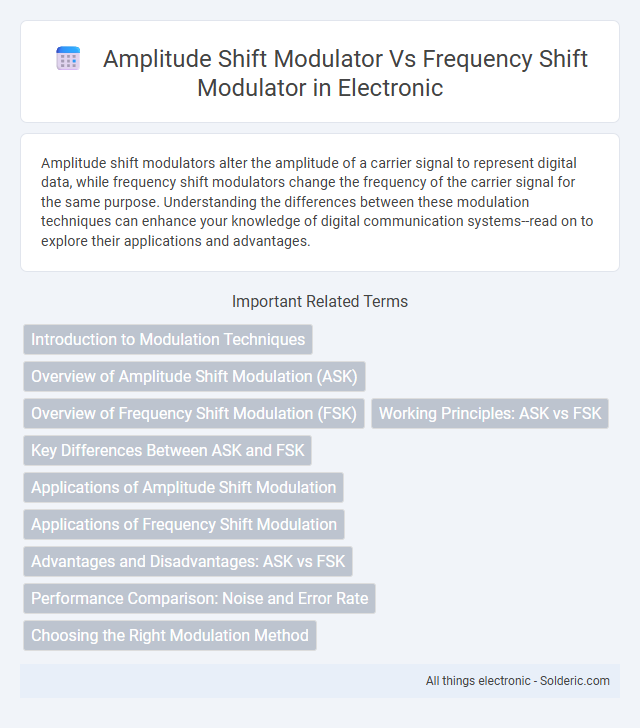Amplitude shift modulators alter the amplitude of a carrier signal to represent digital data, while frequency shift modulators change the frequency of the carrier signal for the same purpose. Understanding the differences between these modulation techniques can enhance your knowledge of digital communication systems--read on to explore their applications and advantages.
Comparison Table
| Feature | Amplitude Shift Modulator (ASK) | Frequency Shift Modulator (FSK) |
|---|---|---|
| Modulation Type | Amplitude varies | Frequency varies |
| Signal Representation | Different amplitudes represent binary data | Different frequencies represent binary data |
| Noise Resistance | Low - sensitive to amplitude noise | Higher - less affected by amplitude noise |
| Bandwidth Requirement | Narrow bandwidth | Wider bandwidth needed |
| Complexity | Simple modulator/demodulator | More complex modulator/demodulator |
| Power Efficiency | Less power-efficient | More power-efficient |
| Common Applications | Low-speed digital transmission, Optical fiber | Radio transmission, Wireless communication |
| Error Performance | Higher bit error rate in noisy channels | Lower bit error rate in noisy channels |
Introduction to Modulation Techniques
Amplitude shift modulation (ASM) varies the amplitude of a carrier signal to represent digital data, making it essential in communication systems where signal power changes encode information. Frequency shift modulation (FSM) changes the carrier frequency to transmit data, offering improved noise immunity over amplitude-based methods. Understanding these modulation techniques helps you select the appropriate method for efficient and reliable wireless communication systems.
Overview of Amplitude Shift Modulation (ASK)
Amplitude Shift Keying (ASK) is a modulation technique where the amplitude of the carrier signal is varied in accordance with the digital data, representing binary values through distinct amplitude levels. ASK offers simple implementation and is commonly used in optical fiber communication and low-frequency applications but is more susceptible to noise and signal degradation compared to Frequency Shift Keying (FSK). Your choice between ASK and FSK depends on the system requirements for bandwidth efficiency and noise resilience.
Overview of Frequency Shift Modulation (FSK)
Frequency Shift Keying (FSK) is a digital modulation technique where the frequency of a carrier signal is varied in accordance with the digital data stream, representing binary values as distinct frequencies. It offers improved noise immunity and better performance in noisy environments compared to Amplitude Shift Keying (ASK), making it widely used in communication systems like radio transmitters and modems. FSK's primary advantage lies in its robustness against signal degradation, ensuring reliable data transmission over voice channels and radio bands.
Working Principles: ASK vs FSK
Amplitude Shift Keying (ASK) modulates the amplitude of a carrier wave to represent binary data, where the presence or absence of a signal indicates different bits. Frequency Shift Keying (FSK) varies the frequency of the carrier wave between distinct values to encode digital information, maintaining constant amplitude. Your choice between ASK and FSK depends on factors like noise immunity, with FSK generally offering better performance in noisy environments due to its frequency variation approach.
Key Differences Between ASK and FSK
Amplitude Shift Keying (ASK) modulates the signal by varying its amplitude, while Frequency Shift Keying (FSK) changes the frequency of the carrier wave to represent data. ASK is more susceptible to noise and signal degradation but offers simpler implementation and lower power consumption. FSK provides greater noise immunity and better performance in environments with interference, making it suitable for robust communication systems.
Applications of Amplitude Shift Modulation
Amplitude Shift Modulation (ASM) is commonly utilized in digital communication systems, including optical fiber communication and telemetry, where efficient amplitude variation detection is essential. ASM offers simplicity and cost-effectiveness, making it ideal for low-power wireless sensor networks and indoor radio broadcasting. Your choice of ASM is advantageous for applications requiring straightforward demodulation and lower susceptibility to frequency-related interference.
Applications of Frequency Shift Modulation
Frequency shift modulation (FSK) is widely used in digital communication systems due to its robustness against noise and interference, making it ideal for applications such as data transmission in telemetry, caller ID, and low-speed modems. Wireless communication systems utilize FSK for reliable signal transmission over varying distances, including RFID and Bluetooth technologies. Your choice of modulation can enhance performance in industrial automation and secure radio transmissions where frequency stability is critical.
Advantages and Disadvantages: ASK vs FSK
Amplitude Shift Keying (ASK) offers simpler implementation and higher bandwidth efficiency compared to Frequency Shift Keying (FSK), making it suitable for cost-sensitive, low-data-rate applications. However, ASK is more susceptible to noise and signal attenuation, leading to poorer performance in noisy environments. FSK provides better noise immunity and reliable data transmission under varying channel conditions, yet it requires more complex circuitry and bandwidth.
Performance Comparison: Noise and Error Rate
Amplitude shift modulators exhibit higher susceptibility to noise, leading to increased error rates in environments with significant signal interference. Frequency shift modulators demonstrate better noise immunity due to constant amplitude signals, resulting in improved performance under noisy conditions. The lower bit error rate (BER) in frequency shift modulation makes it more reliable for communication systems demanding robust data integrity.
Choosing the Right Modulation Method
Choosing the right modulation method depends on your specific communication requirements, such as bandwidth efficiency, noise immunity, and power consumption. Amplitude Shift Keying (ASK) offers simple implementation and lower bandwidth utilization but is more susceptible to noise and amplitude distortion. Frequency Shift Keying (FSK) provides better noise resistance and is preferred for wireless and long-distance communication where signal integrity is crucial.
Amplitude shift modulator vs frequency shift modulator Infographic

 solderic.com
solderic.com